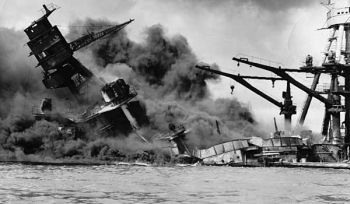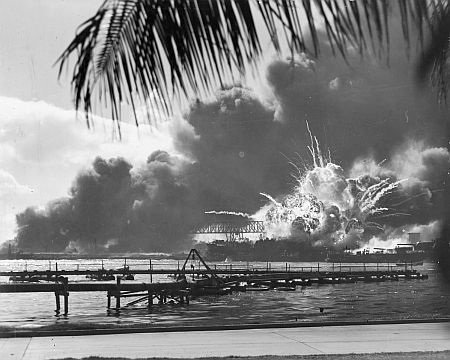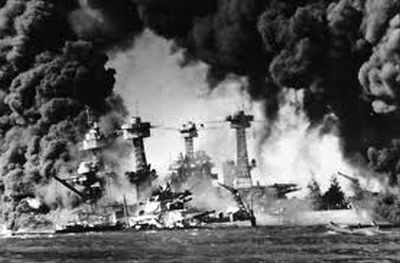
Publisher:
Bonnie King
CONTACT:
Newsroom@Salem-news.com
Advertising:
Adsales@Salem-news.com

~Truth~
~Justice~
~Peace~
TJP
Dec-05-2013 22:10

 TweetFollow @OregonNews
TweetFollow @OregonNews
America Caught Unaware: Behind the Bombings at Pearl Harbor
Barry Lee Coyne Sakem-News.comWe were caught taking a disastrous nap, and the enemy exploited that gap.
 The Day that will Live in Infamy |
(SALEM) - We were caught taking a disastrous nap, and the enemy exploited that gap.
President Franklin D. Roosevelt called Dec. 7th, 1941 as "a day that will live on in the infamy of man", referring to the massive sneak attack that day that nearly wiped out America's entire Pacific fleet. Many were killed and injured. Most young people today know little of how that came about.
At that time, Japan viewed the US as a formidable barrier to extending its empire to all of Southeast Asia. It had already invaded China and occupied coastal areas as far south as Shanghai. Both the Marshall and Mariana Islands to the west of The Philippines, then a US possession, had fallen under Japanese control, as had the strategic island of Taiwan.
When French Indochina next fell to Japan, FDR felt a threat to America. He issued an executive order which created an embargo on sending oil to Japan. Certain metals for their war machine were included as well. The Philippines was now essentially boxed in on three sides. Only the southern portion next to New Guinea and the Dutch East Indies (now Indonesia) was a viable escape route.
 The economy played a huge part in Japan's conquest of these territories. The East Indies provided the US with rubber and oil. The Philippines was a key source of rubber and iron. The Emperor's war machine enviously eyed these raw materials, and considered US naval power the only obstacle to its access.
The economy played a huge part in Japan's conquest of these territories. The East Indies provided the US with rubber and oil. The Philippines was a key source of rubber and iron. The Emperor's war machine enviously eyed these raw materials, and considered US naval power the only obstacle to its access.
Admiral Yamimoto was commissioned by the Emperor to develop a plan to wipe out our Pacific Fleet before it could strike back. He had studied in the US and was familiar with American culture. It is said that he believed the Yankees were like a sleeping giant that could be crushed if Japan pulled a surprise. Some two years were spent by the Japanese fine-tuning their plan. They did not expect WW II to result.
With FDR as president, much attention was consumed by domestic projects to recover America from the Great Depression. Investing in munitions was not yet a priority. However, Japan was increasingly seen as a possible threat at some point. After Indochina fell, that concern intensified. The relocation of the US Pacific Fleet naval base from S. California to Honolulu, Hawaii, was our military response.
Following the oil embargo, the Emperor grew angry. Reports of sharp anti-Oriental attitudes in the US only served to exacerbate the situation. Admiral Yamamoto got his marching orders: plot a way to cripple the American fleet. The theory was that it would take years to rebuild it, while Japan could run rampant without serious opposition.
The US had been poised for a naval invasion, assuming that our adversary would never be able to fly their planes from distant Japan all the way to Hawaii. Yamamoto found an alternate route. Rather that battleships, he opted for a group of aircraft carriers. They left from Northern Japan on November 26 (ironically that was the very date I was born). Their plan was threefold:
- Utilize dive bombers of an air attack on Oahu;
- Launch a torpedo assault in Pearl Harbor itself;
- Set up mini subs to sink any US ships in flight.
The attack strategy involved six carriers with Japan's 183 planes leaving the deck at 6 am poised for Hawaii. Flying time was calibrated at two hours. The six American airfields would be targeted first, then the USS Ward nearby. An airman at Opana radar station took note of the incoming planes and duly reported this up the chain. He was told not to worry, that it must be a US air fleet expected from California.
Had his warning been taken, US history might have had a far different twist of fate.
Meanwhile, the Japanese air commander led his flyers with the chant of "Tora! Tora! Tora!" That was the code word for "tiger" which was deemed to attack its prey surreptitiously. These dive bombers swiftly took aim at our air bases at Bellows, then Wheeler, Hickam, and Eva. Our planes were flattened and destroyed. Then onward to Pearl Harbor.
 It was early Sunday morning, a faith day to most Americans. Preparation for hoisting the colors for Sunday services was just getting underway when the first series of torpedoes was launched. The US had assumed that the shallow harbor would be torpedo-proof. They were dead wrong. Japan had secretly invented a new variety that spelled doom for the assembled US Fleet.
It was early Sunday morning, a faith day to most Americans. Preparation for hoisting the colors for Sunday services was just getting underway when the first series of torpedoes was launched. The US had assumed that the shallow harbor would be torpedo-proof. They were dead wrong. Japan had secretly invented a new variety that spelled doom for the assembled US Fleet.
Gasps ensued. The pungent vapors of underwater bombs soon filled the air. The West Virginia and the Oklahoma were immediately hit. The Arizona and Tennessee caught fire and collapsed. Many men were beneath deck headed to their underwater inferno. Observors describe what they saw as "scenes from hell". Even the water was aflame as the oil copiously spouted everywhere.
At precisely 8:06, the Japanese planes left, feeling triumphant.
It was to be a half-hour respite, however. At 9 am the second contigent of Japan's bombers came in for a final killer mission. This time, American anti-aircraft were ready. The Emperor's finest lost five planes this time. A final headcount listed 21 vessels sunk or badly damaged that day. Some 188 US planes on the ground were blown to smithereens. Among the dead were 2390 victims, some 49 of them innocent civilians. Thus began our involvement in WW II.
Yes, we proved to be the proverbial Sleeping Giant. Pearl Harbor became our wake-up call which made the USA truly united to fight back, and ultimately to attain a difficult victory.
Respectfully submitted,
B. Lee Coyne
NOTE: B. Lee Coyne invites comments at notcoy@netzero.net.
NOTE: B. Lee Coyne first emerged as a Caucasian cub reporter for the Black weekly NY Voice and was assigned to cover numerous civil rights struggles. It has left its indelible mark on his mindset. He can be contacted at: notcoy@netzero.net.

B. Lee Coyne, a NYC native, blends three careers: Journalist, Counselor, Educator. His writings have appeared in newspapers and magazines on the East and West Coasts and the Southwest. He loves the art of the interview and has covered such persons as Dr. King's 1963 "Dream" speech and Sen. William
Proxmire as an advocate for the environment. A global traveller to some 30 countries aboard, he speaks Spanish semi-fluently and very rudimentary Russian, Tagalog, German, Arabic and Hebrew.
Lee's legacy here in Salem includes launching the Salem Peace Mosaic at the YMCA and doing a radio talk show for KMUZ/88.5 FM. It airs Mondays and highlights lives of proactive, productive senior citizens. He invites you to contact him at: notcoy@netzero.net.
Articles for December 4, 2013 | Articles for December 5, 2013 | Articles for December 6, 2013
Quick Links
DINING
Willamette UniversityGoudy Commons Cafe
Dine on the Queen
Willamette Queen Sternwheeler
MUST SEE SALEM
Oregon Capitol ToursCapitol History Gateway
Willamette River Ride
Willamette Queen Sternwheeler
Historic Home Tours:
Deepwood Museum
The Bush House
Gaiety Hollow Garden
AUCTIONS - APPRAISALS
Auction Masters & AppraisalsCONSTRUCTION SERVICES
Roofing and ContractingSheridan, Ore.
ONLINE SHOPPING
Special Occasion DressesAdvertise with Salem-News
Contact:AdSales@Salem-News.com
Salem-News.com:




Terms of Service | Privacy Policy
All comments and messages are approved by people and self promotional links or unacceptable comments are denied.
Franklin Churchill December 11, 2013 6:40 pm (Pacific time)
Nice fairy tale, too bad it isn't true. The War Department broke the Jap military code nearly TWO years before Pearl Harbor, so FDR knew the 'sneak' attack was going to take place. That's why he got the aircraft carriers out and left the WWI battleships and destroyers at Pearl, sacrificing them and the men so he could drag the USA into WWII.
Luke Easter December 6, 2013 7:38 pm (Pacific time)
Unaware, lazy or maybe incompetent? Just like 911, info was there but no follow-up.
[Return to Top]©2025 Salem-News.com. All opinions expressed in this article are those of the author and do not necessarily reflect those of Salem-News.com.